Nestled in the North Central Coast region of Vietnam, Huế ([hwě]), the venerable capital of Thừa Thiên Huế Province, is a tapestry of profound history and vibrant culture. Acting as the historical epicenter of Đàng Trong and the illustrious Nguyễn Dynasty, it unveils chapters of a bygone era, encapsulating the essence of Vietnam’s storied past. With the UNESCO-recognized Complex of Huế Monuments standing as a testament to its imperial legacy, the city invites exploration, featuring an array of palaces, sacred shrines, and the enigmatic Forbidden Purple City — the former abode of emperors. The reconstructed Royal Theater, along with various other landmarks under restoration, further cements Huế as a magnet for history enthusiasts, having attracted an impressive 4.2 million visitors in 2019. Each step within its ancient walls whispers tales of imperial and colonial grandeur, offering a glimpse into a fascinating narrative meticulously crafted over time.
History of Hue
Ancient Foundations: Kingdom of Lâm Ấp (4th Century AD)
Huế boasts ancient ruins dating back to the Kingdom of Lâm Ấp in the 4th century AD, with its earliest capital, Kandarpapura (‘the city where Śiva burnt Kama’), nestled in Long Tho Hill just three kilometers west of the current city. Established perhaps during the reign of Kandarpadharma (629–640 AD), Kandarpapura wasn’t likely the original Lâm Ấp capital but was named in honor of the king. Additional ruins, like the 9th-century city of Hoa Chau, offer further glimpses into the Champa era.
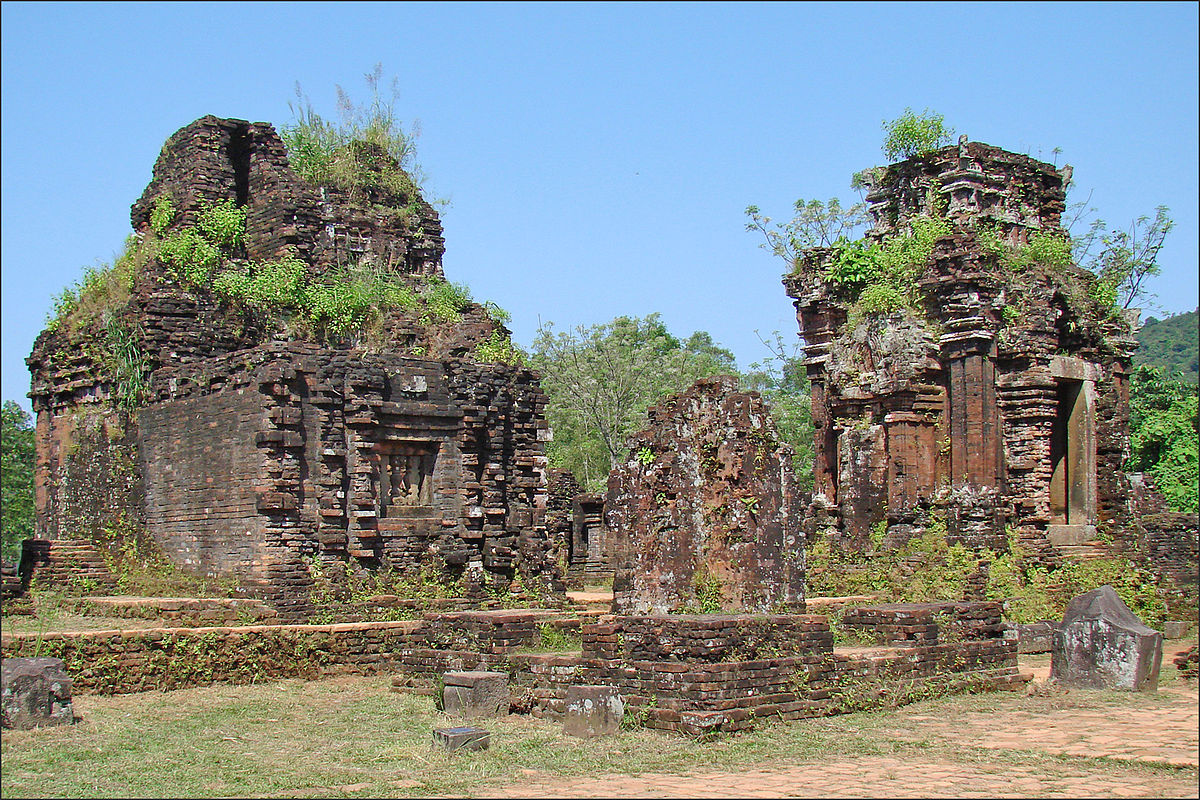
Champa-Vietnam Alliance (1306 AD)
A pivotal moment arrived in 1306 when Champa’s King, Che Man, offered two prefectures, O and Ly, to Vietnam. In exchange, he sought the hand of the Vietnamese princess, Huyen Tran. The Vietnamese King Tran Anh Tong agreed, rechristening the received territories as Thuan and Hóa prefectures, collectively known as the Thuan Hoa region.
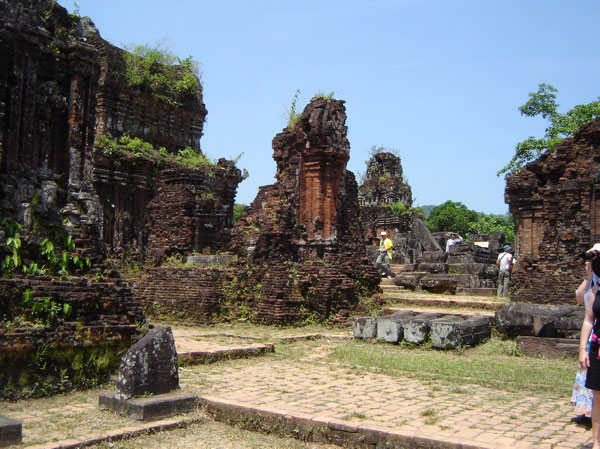
Political Turmoil and Power Struggles (1592 AD)
The tapestry of Huế’s history continued to weave intricate patterns in 1592 as the Mac dynasty was ousted, retreating to Cao Bang province. Meanwhile, the Le dynasty ascended with Nguyen Kim spearheading the loyalist faction. After Nguyen Kim’s untimely death by poisoning, a power struggle ensued, resulting in the assassination of his eldest son, Nguyen Uông. Another of Kim’s sons, Nguyen Hoang, wary of meeting a similar fate, feigned insanity. With his sister’s intercession, Hoang was appointed the ruler of Thuan Hoa, then Vietnam’s southernmost region.
Civil War and Nguyen Lords Era
With Mac dynasty loyalists stirring rebellion in Thuan Hoa and Trinh Kiem engaging the Mac forces in the north, Ngoc Bao’s request for her brother, Nguyen Hoang, to govern the southern region was granted. Successfully stabilizing Thuan Hoa, Nguyen Hoang, alongside his successor Nguyen Phuc Nguyen, covertly shifted the region’s allegiance to the Nguyen family, eventually opposing the Trinh lords. This maneuver ignited a civil war between the Nguyen and Trinh clans, two dominant powers of the time.
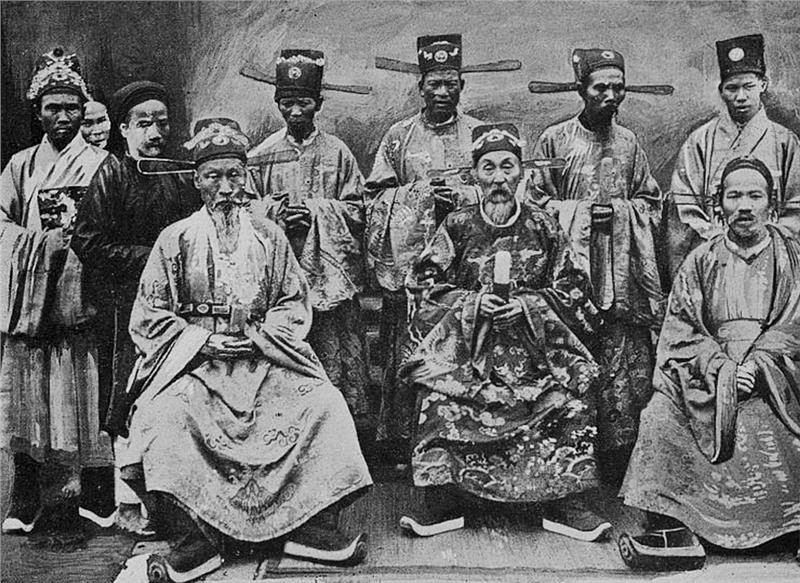
The strategic northern area of Thuan Hoa, Thua Thien, was selected as the Nguyen family’s base. In 1687, under the rule of Nguyen lord Nguyen Phuc Tran, construction commenced on a citadel in Phu Xuan, a village situated within Thua Thien. Rather than serving purely defensive purposes, the citadel symbolized the might of the Nguyen clan, especially since the Trinh lords were unable to penetrate the fortifications at Phu Xuan. In 1744, Phu Xuan ascended in prominence, becoming the capital of central and southern Vietnam as Nguyen lord Nguyen Phuc Khoat declared himself Vo Vương (Martial King). Among the foreigners residing in the burgeoning capital was Portuguese Jesuit João de Loureiro, who lived there starting in 1752.
Tay Son Rebellions and Changes in Control (1771 AD)
In 1771, the Tay Son rebellions erupted and swiftly expanded their control from Quy Nhon to Binh Thuan Province, significantly diminishing the power of the Nguyen lords. While the conflict between the Tay Son rebels and the Nguyen lords unfolded, the Trinh lords seized the opportunity to deploy a substantial army southwards, effortlessly taking control of Phu Xuan in 1775. Following this conquest, Trinh general Hoang Ngu Phuc strategically allied with Tay Son, withdrawing the majority of his forces to Tonkin and maintaining a smaller garrison in Phu Xuan.
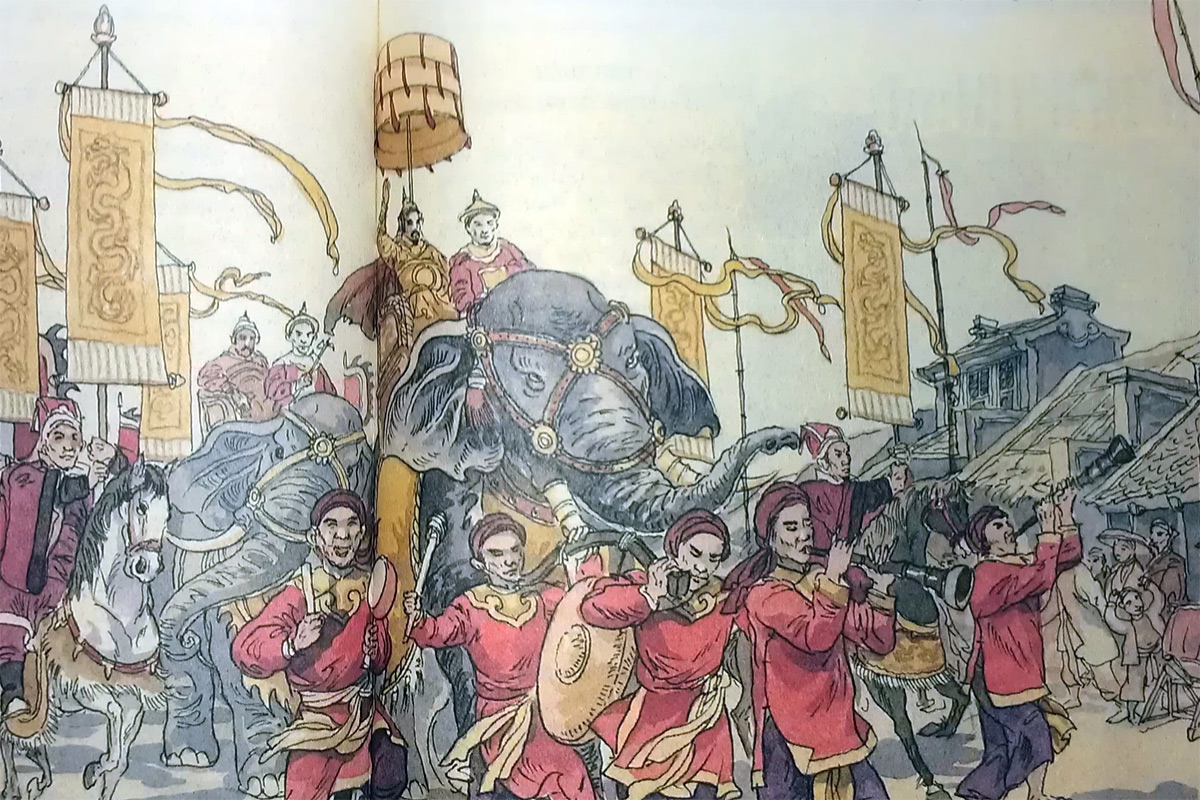
The Tay Son rebels eventually overcame the Trinh garrison in 1786, claiming Phu Xuan for themselves. Under Emperor Quang Trung’s rule, Phu Xuan was designated as the capital of the Tay Son dynasty. However, in 1802, Nguyen Anh, a descendant of the Nguyen lords, reclaimed Phu Xuan and united the nation. He undertook extensive reconstruction of the citadel, transforming it into the Imperial City and the capital of Vietnam.
Nguyen Dynasty Establishment (1802 AD)
The year 1802 also marked Nguyen Phuc Anh’s (later known as Emperor Gia Long) consolidation of control over Vietnam, establishing Hue as the national capital. Following him, Minh Mang ascended to the throne as the second emperor of the Nguyen dynasty from 1820 to 1841. A son of Emperor Gia Long, Minh Mang was recognized for his staunch opposition to French involvement in Vietnam and his steadfast adherence to Confucian orthodoxy.
French Colonial Era and Protectorate of Annam
During the era of French colonialism, Hue fell under the protectorate of Annam, continuing as the site of the Imperial Palace until 1945. In this pivotal year, Emperor Bao Dai relinquished his throne, paving the way for the inception of the Democratic Republic of Vietnam (DRV), which selected Hanoi in the northern region as its capital.
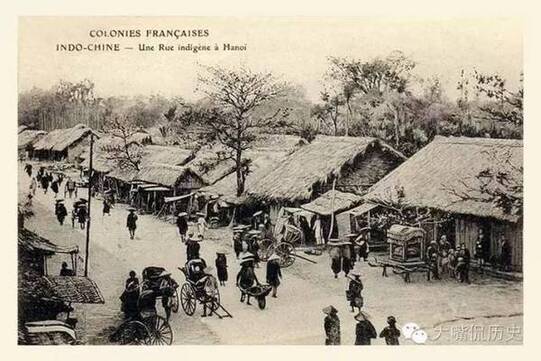
In 1949, with the assistance of the reinstated French colonialists, Bao Dai was declared the “Head of the State of Vietnam”. However, this designation did not garner acknowledgment from the communist factions nor wholehearted acceptance from the Vietnamese populace. Subsequently, Bao Dai established his new capital in Saigon, situated in the southern part of the country.
Vietnam War and Battle of Hue (1968)
Hue’s historical significance is further underscored by its role in the Vietnam War, serving as the stage for the Battle of Hue, one of the conflict’s longest and most brutal confrontations. Given its proximity to the demarcation line separating North and South Vietnam, Hue was inevitably a strategically crucial and thus vulnerable location during the war. The 1968 Tet Offensive saw the Battle of Hue inflict substantial damage upon the city. This devastation was not limited to its architectural heritage but also extended to its reputation, due to the dual impacts of American bombardments targeting historic structures occupied by North Vietnamese forces and the infamous Massacre at Hue.

Post-War Period and Restoration Efforts (Post-1975)
Post the 1975 war conclusion, numerous historic elements of Huế found themselves neglected, as the triumphant communist regime and certain sections of the Vietnamese populace deemed these as “relics from the feudal regime”. The Nguyen Dynasty was labeled as “feudal” and “reactionary” according to the doctrines of the Communist Party of Vietnam (initially known as the Workers’ Party of Vietnam). However, this viewpoint underwent a transformation, paving the way for the restoration of many of Huế’s historical districts. Presently, the city is undergoing development as a pivotal center for tourism and transportation within the central region of Vietnam, highlighting a renewed appreciation for its rich heritage.
Hue’s Geography

Situated in central Vietnam along the serene Hương River, the city of Huế nestles just a short distance inland from the East Sea. Strategically located, it is approximately 700 km south of the capital Hanoi and about 1,100 km north of the bustling Ho Chi Minh City. The city’s boundaries touch Quảng Điền District and the expansive South China Sea to the north, while Hương Thủy town lies to the south and east, Phú Vang District to its immediate east, and Hương Trà town to the west.
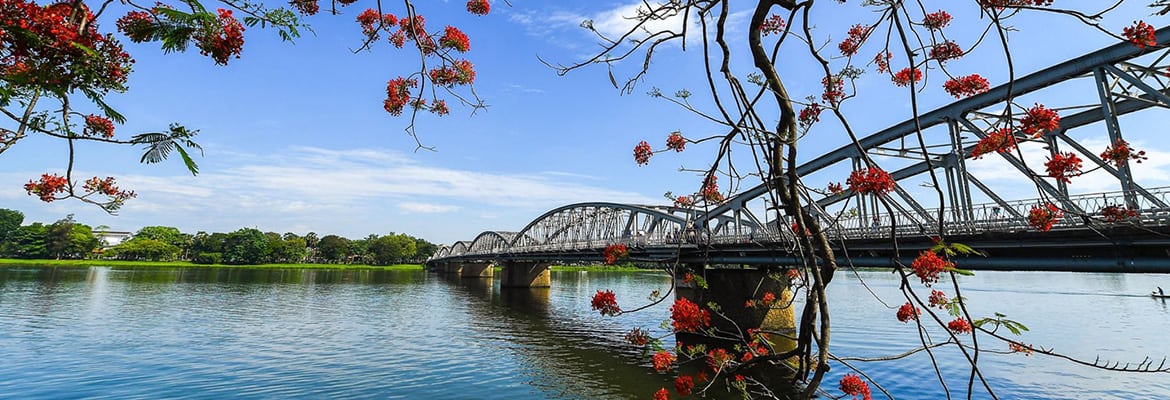
Huế gracefully straddles the banks of the Hương River, positioned north of the iconic Hải Vân Pass, and is conveniently situated 105 km from Danang, 14 km from the access points of Thuận An Seaport and Phu Bai International Airport, and a mere 50 km from Chân Mây Port. With a natural expanse of 71.68 km2 and a population estimated at 344,581 in 2012, the city has seen significant growth. Following territorial expansions, as of 2021, Huế sprawls over 265.99 km2, housing a vibrant population of 652,572 individuals, inclusive of non-registered residents.
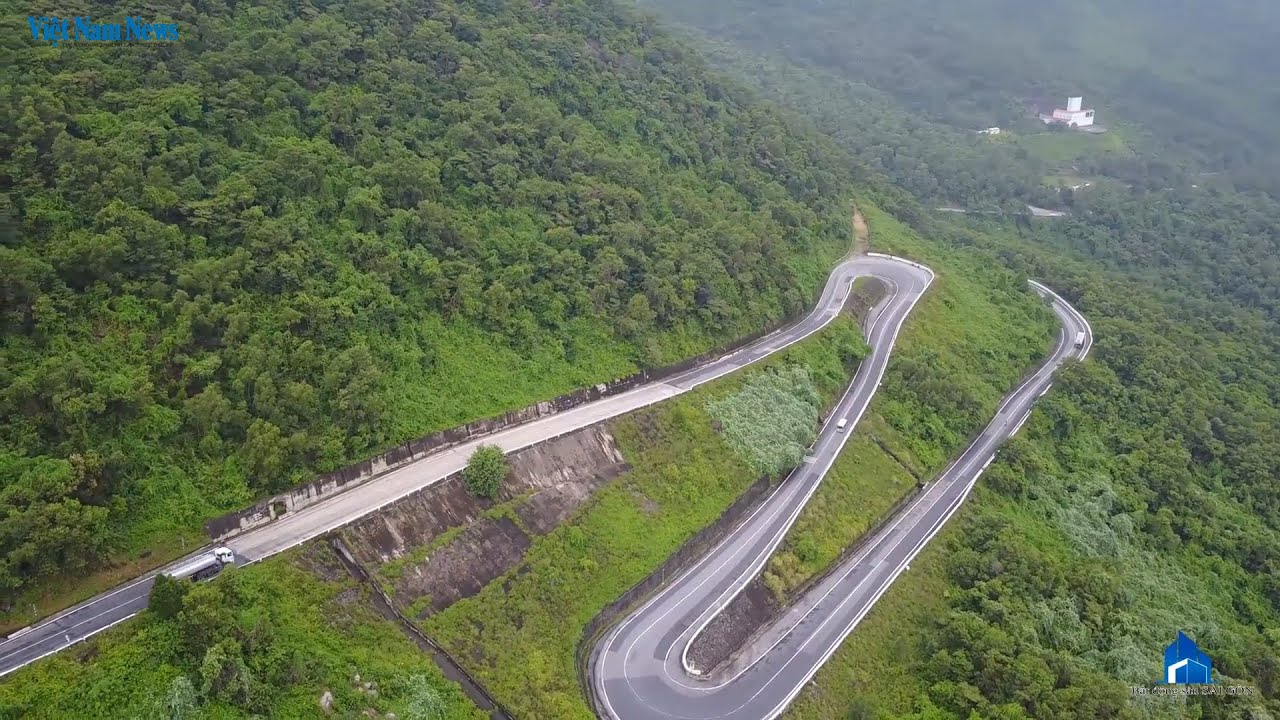
Nestled near the majestic Trường Sơn mountain range, Huế unfolds across a plain in the lower reaches of the Perfume and Bo rivers. With its landscape characterized by a subtle elevation of 3–4 m above sea level, the city occasionally experiences flooding during periods of moderate to heavy rainfall in the river headwaters of Hương. Despite its largely flat terrain, Huế is interspersed with gentle hills and low mountains, including notable features like the Ngự Bình mountain and Vong Canh Hill, adding to its picturesque and varied topography.
Culture
Nestled in the heart of Vietnam, Hue boasts a rich history as the nation’s capital for approximately 150 years during the feudal era (1802–1945). This significant period saw the city immersed in royal customs and lifestyles that have left an indelible mark on the characteristics and disposition of its residents, an influence that continues to echo through time.
Name-Giving Tradition in Hue: A Royal Legacy
Delving into Hue’s cultural nuances, one can observe how deeply the royal values are ingrained in the city’s tradition, particularly in the practice of name-giving. Traditionally, members of the royal family were named following the principles set forth in a poem penned by Minh Mạng, the second emperor of the Nguyen Dynasty. This revered poem, known as “Đế hệ thi”, not only served as a guiding framework for naming each generation of the royal family but also illuminated the familial hierarchy and relationships among its members.

Beyond mere nomenclature, the names derived from this poem encapsulated the virtues and qualities that the royal lineage aspired to embody and promote. Each name, thus, is more than an identity; it’s a beacon of the individual’s inherent traits and the legacy they are meant to uphold. In modern times, this name-giving tradition is held in high esteem among the descendants of Hue’s royal family. Individuals who hail from what are considered ‘pure’ Hue royal family branches continue to receive names inspired by the venerable words of the “Đế hệ thi” poem, preserving a tradition that is quintessentially Hue.
Clothing: A Glimpse into Hue’s Sartorial Heritage
The heritage of Hue’s clothing tradition is deeply entwined with the city’s historical roots and cultural legacy. The ao dai, a distinctive Vietnamese national dress, traces its evolution back to the 18th-century court attire worn in Hue during the era of the Nguyen lords.

Festival in Hue: A Tapestry of Tradition and Elegance
During these times, both men and women adorned gowns characterized by straight collars and short sleeves as described in the historical records of Đại Nam thực lục. Depending on the climate, these gowns sported either large or small sleeves, with seams meticulously stitched down from the sleeves on both sides, rendering a seamless, enclosed silhouette. Men had the option to opt for rounded collars and shorter sleeves, allowing ease of movement and convenience during work.

This unique style underwent a significant transformation, eventually morphing into the áo ngũ thân – a sophisticated, five-paneled gown that graced the aristocracy in the 19th and early 20th centuries. Influenced by the elegant fashions of Paris, artists like Nguyen Cat Tuong, in collaboration with Hanoi University, reimagined and modernized the ngũ thân during the 1920s and 1930s, presenting a dress that was both contemporary and deeply rooted in tradition.
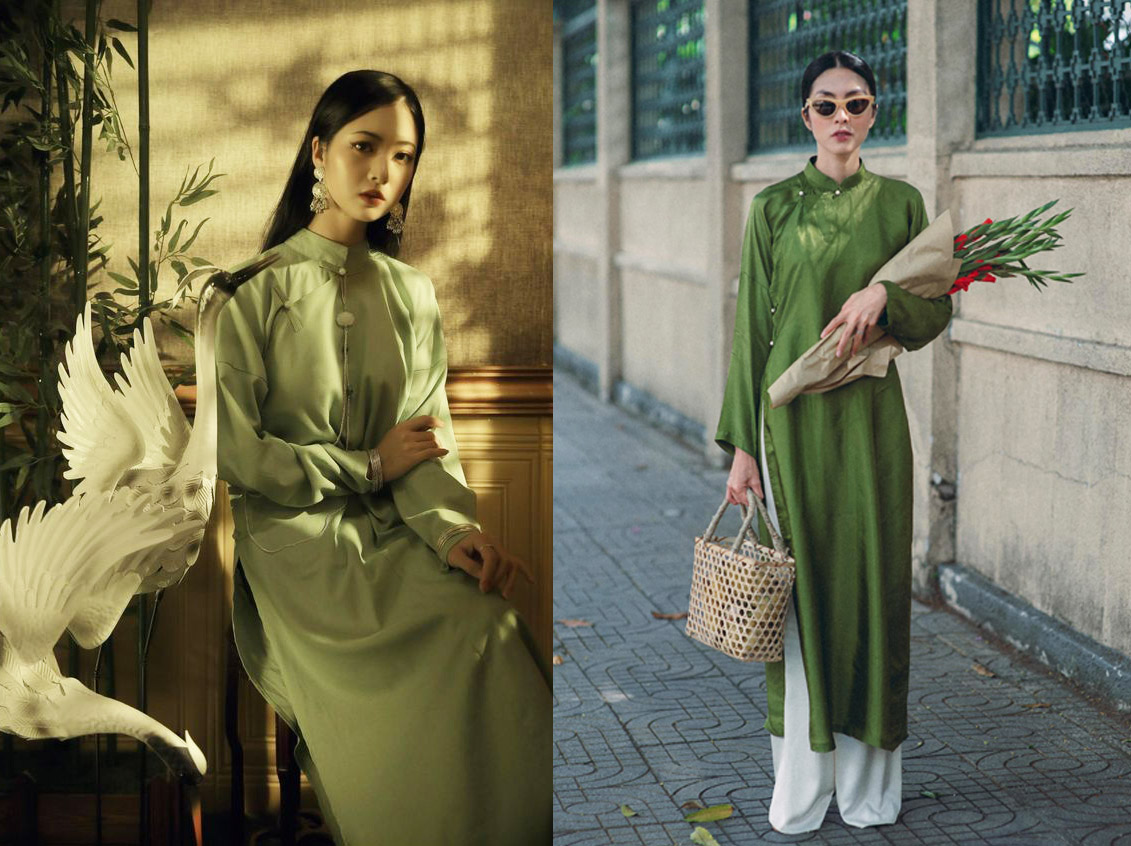
Today, the ao dai and non-la (Vietnamese conical hat) ensemble is not only a symbol of Vietnam but holds particular significance and nostalgia for the people of Hue. In a nod to its historical capital status, Hue has a notable preference for violet-colored ao dai, a hue that beautifully mirrors the city’s royal past and vibrant cultural tapestry. Each garment is not just a piece of clothing but a whisper of stories, traditions, and the undying legacy of Hue.
A Culinary Tapestry: The Unique Flavors of Hue’s Cuisine
Embodied in the aromatic Bun Bo Hue, the city’s culinary landscape is a tantalizing blend of the lavish and the humble, weaving a gastronomic tale that is distinctly Hue. As the cradle of Central Vietnamese cuisine, Hue boasts a culinary heritage that is as rich and diverse as its historical tapestry.
Vegetarian Delights: Harmony on a Plate
In the bustling corners of Hue, vegetarianism isn’t merely a dietary choice; it’s a symphony of belief, tradition, and a deep reverence for life. With a multitude of all-vegetarian eateries dotting the cityscape, locals indulge in vegetarian feasts twice a month, a practice deeply embedded in their Buddhist philosophical ethos. The city hosts traditional dining halls like Nam Châu Hội Quán, where vegetarian dishes aren’t just served; they are celebrated.
From Royal Palates to Everyday Tables: A Symphony of Flavors
Hue’s culinary canvas is vivid and multifaceted, offering a spectrum from the elegantly sophisticated to the delightfully simple. The city’s dishes, often presented in modest servings but with an artistic finesse, whisper tales of a culinary tradition born in the royal kitchens of the Nguyen lords and emperors. Each dish, meticulously crafted, was once designed to delight the discerning palates of the royal and their consorts, mirroring the city’s historical allure and gastronomic innovation.
The Spicy Soul of Hue’s Cuisine
What sets Hue’s cuisine apart is its fearless embrace of spices, crafting dishes that are as fiery and spirited as the city itself. Each bite offers a burst of flavors, a celebration of heritage and the timeless beauty of a city that lives and breathes in each of its culinary creations. With dishes ranging from the extravagant to the earthy, Hue’s cuisine is a delectable journey through the ages, pleasing palates and telling stories of a city intimately tied to its food.
Beyond the acclaimed Bun Bo Hue, the city unveils a menu brimming with culinary treasures:
1. Bánh Bèo:
Originating from Hue, Bánh Bèo is a delightful concoction of rice and tapioca flour. Served with rice cakes, marinated dried shrimps, crispy pork skin, scallion oil, and a flavorful dipping sauce, this versatile dish can be enjoyed as a snack, lunch, or dinner, embodying the spirit of Hue’s vibrant street food scene.

2. Cơm Hến (Baby Basket Clams Rice):
A quintessential Hue dish, Cơm Hến is a sublime mixture of baby mussels or basket clams and rice, typically served at room temperature. Each bite offers a taste of the city’s culinary heritage and the freshness of its local produce.

3. Bánh Ướt Thịt Nướng (Steamed Rice Pancake with Grilled Pork):
A favorite amongst the residents of Kim Long, Hue, this dish features steamed rice pancakes paired with an assortment of fresh herbs, succulent grilled pork, and a tantalizing dipping sauce, making it a beloved choice for many.

4. Bánh Khoái (Hue Shrimp and Vegetable Pancake):
A delightful variation of Bánh Xèo, Bánh Khoái is a crispy, deep-fried pancake served with a unique Hue-style peanut dipping sauce. Its rich tapestry of ingredients includes eggs, liver, prawns, pork belly or sausage, and carrot, harmoniously coming together to create a symphony of taste.

5. Bánh Bột Lọc (Clear Shrimp and Pork Dumplings):
With origins tracing back to the Nguyen Dynasty, this Hue speciality can be enjoyed with or without banana leaf wrapping. Crafted with tapioca flour, shrimps, and pork belly, these dumplings are usually accompanied by a sweet chili fish sauce.

6. Banh It Ram (Fried Sticky Rice Dumpling):
A true Central Vietnamese specialty, Banh It Ram showcases the delightful contrast between its soft, chewy upper layer and the crispy, golden bottom, offering a textural experience like no other.

Sweet Notes of Hue:
The city is also celebrated for its exquisite sweet desserts, ranging from the elegant Lotus Seeds Sweet Soup, the exotic Areca Flower Sweet Soup, to the delightful Green Sticky Rice Sweet Soup, each promising a delightful finish to your gastronomic adventure in Hue.
Religion
Pagoda of the Celestial Lady
Hue is a city deeply rooted in religious practices, where the imperial court once engaged in various religious observances encompassing Buddhism, Taoism, and Confucianism. The Esplanade of Sacrifice to the Heaven and Earth, a pivotal altar in the city, bore witness to annual prayers offered by the monarch to the Heaven and Earth, illuminating the city’s spiritual tapestry.

Hue stands as a bastion of Buddhism, garnering unparalleled support within its borders compared to the rest of Vietnam. With an extensive network of monasteries—each one more enchanting than the last—the city served as the residence for the nation’s most esteemed monks, offering a sanctuary for those in pursuit of spiritual enlightenment.
1963 saw Thich Quang Duc embarking on a momentous journey from Hue to Saigon, driven by a resolution to challenge the South Vietnamese government’s anti-Buddhist policies. This odyssey culminated in his iconic self-immolation on the bustling streets of Saigon, with photographs capturing this poignant moment echoing through history as symbols of the Vietnam War.

Moreover, Hue is the hometown of the globally revered Zen Master Thich Nhat Hanh. After years of living in exile across various countries, including France and the United States, he made a triumphant return to Hue in October 2018. Until his passing in 2022, he resided in the serene confines of the Tu Hieu Pagoda, further entrenching Hue’s status as a city of spiritual significance and allure.
UNESCO’s World Heritage: Historic Monuments of Hue
Hue, celebrated for its historic monuments, has garnered recognition as a UNESCO World Heritage Site. The city was the nucleus of power for the Nguyen emperors, with the Imperial City at its core. This walled enclosure, situated on the northern banks of the Perfume River, housed the Forbidden City, a secluded realm accessible only to emperors, concubines, and select confidants—with death as the penalty for unauthorized entry. While time has eroded much of the Forbidden City, ongoing restoration efforts aim to preserve this historic site for tourists.

Sprawling along the scenic Perfume River, a series of monumental tombs honor the memory of emperors like Minh Mang, Khai Dinh, and Tu Duc. The Thien Mu Pagoda, standing as the largest in Hue, also symbolizes the city’s rich heritage.
The cityscape also features French-style edifices along the Perfume River’s southern bank, including the venerable Hue High School for the Gifted and Hai Ba Trung High School.
Housed on 3 Le Truc Street, the Huế Museum of Royal Fine Arts proudly displays a spectrum of artifacts reflecting the city’s legacy. Beyond its confines, Hue serves as a gateway for day trips to the Demilitarized Zone (DMZ), approximately 70 km north, where visitors can explore historic war sites like The Rockpile, Khe Sanh Combat Base, and the Vinh Moc Tunnels. The vibrant backpacker district, composed of Pham Ngu Lao, Chu Van An, and Vo Thi Sau streets, hosts a variety of hotels, bars, and restaurants catering to tourists.

In 2012, Hue witnessed a surge in tourism, attracting 2.4 million visitors in the first 11 months—a 24.6% increase from 2011. Foreign tourists accounted for 803,000 of these visits, marking a 25.7% growth. While tourism undoubtedly fuels the city’s socioeconomic engine, it also imposes environmental strains and resource depletion. The tourism-linked services, infrastructure development, and goods production and consumption are all energy-intensive processes that have their environmental impacts. Initiatives like promoting traditional ‘garden houses’, identified by the Climate and Development Knowledge Network, not only enhance tourism but also contribute to low-carbon development, harmoniously blending environmental conservation with cultural preservation and economic advancement.
Infrastructure
Pioneering Healthcare: Hue Central Hospital
Hue Central Hospital boasts a legacy of healthcare innovation, tracing its origins back to 1894 when it emerged as the first Western-style hospital in Vietnam. With a sprawling 120,000 square meters (30 acres) of space, the hospital provides a substantial capacity of 2,078 beds, standing as one of the nation’s three largest healthcare facilities alongside the renowned Bach Mai Hospital in Hanoi and Cho Ray Hospital in Ho Chi Minh City. The Ministry of Health, responsible for orchestrating healthcare initiatives across the country, oversees the operations of Hue Central Hospital, ensuring it continues to deliver exemplary medical services to the community.
Convenient Transportation Options in Hue
Hue offers efficient transportation networks for both locals and visitors. The Hue Railway Station serves as a crucial connectivity hub, linking Hue with significant cities across Vietnam through the North-South Railway. For those preferring air travel, Phu Bai International Airport is conveniently located just south of the city center, providing easy access for international and domestic flights, making the historic Forbidden Purple City and other attractions in Hue readily accessible.
Transportation to Hue City
Hue City enjoys a strategic location in Vietnam’s center, making it a readily accessible destination whether you’re journeying from Ho Chi Minh City (1100 kilometers south), Hanoi (700 kilometers north), or the neighboring Da Nang City (approximately 100 kilometers away). The city is well-connected, offering multiple modes of transportation for your convenience.
Air Travel:
- Phu Bai Airport (HUI): Positioned close to Hue, Phu Bai Airport is the primary gateway for air travelers. Regular domestic flights operate from major cities like Ho Chi Minh City and Hanoi to Phu Bai. Upon arrival, a short taxi ride of approximately 15 kilometers will transport you to the heart of Hue City.
Rail Travel:
- North-South Railway Connection: Hue boasts a significant railway station on the principal north-south line that seamlessly links Hanoi and Ho Chi Minh City. Opting for train travel offers an immersive experience, presenting spectacular scenic vistas along the way. Passengers can look forward to air-conditioned compartments, cushioned seats, and cozy sleeping arrangements, all provided at economical rates.
Bus Travel:
- Tour Buses: Although time-consuming, buses present a cost-effective alternative. Buses from Da Nang take around 2.5 hours, while those from Hanoi and Ho Chi Minh City require approximately 13 and 25 hours, respectively. Buses terminate at either the Northern or Southern Bus Station in Hue, with online booking options available through various agencies.
Car or Motorbike Travel:
- From Da Nang: A three-hour drive from Da Nang via the scenic National Highway 1 is another viable option. This route traverses the picturesque Hai Van Pass, promising breathtaking views along the coast.
Within-City Transportation:
- Diverse Options: Visitors in Hue can choose from a spectrum of transportation means, including cyclos, motorcycles, bicycles, and taxis, catering to various preferences and requirements. Among these, XANH SM Taxi is a notable mention, renowned for its exemplary service.
Choosing Your Mode of Transport:
Ultimately, your choice of transportation hinges on your priorities, whether it’s speed, comfort, cost, or the desire for a scenic journey. Each mode offers a unique travel experience, and the availability of various options ensures that every traveler can find something that aligns with their needs and expectations.
Nestled in the heart of Vietnam, Hue is not merely a city but a woven tapestry of history, culture, and unparalleled beauty. With its deep historical roots dating back to the 4th century AD and the Kingdom of Lâm Ấp, it offers visitors a unique glimpse into the bygone eras, captivating the hearts of history aficionados and casual travelers alike. The echoes of the Nguyen Dynasty continue to reverberate through the bustling streets, while the serene Perfume River tells tales of ancient glory and recent resilience.
The city’s extraordinary culinary scene is a reflection of its royal past, providing a feast not only for the taste buds but also for the soul. Each dish, meticulously prepared, encapsulates the essence of Hue, telling stories of its rich heritage and the meticulous artistry of its people. Whether you are savoring the renowned Bun Bo Hue, indulging in delicate Bánh Bèo, or exploring the variety of vegetarian delights, the flavors of Hue are sure to leave an indelible mark on your palate.
But Hue isn’t just about relishing in the past; it’s a city that gracefully balances tradition with the pulse of modern life. Amidst its historic ruins and architectural marvels, you’ll find vibrant education centers, efficient healthcare facilities, and a well-connected transportation network, making it not just a travel destination but a testament to Vietnam’s dynamic present and promising future.
Maybe you need: Best Things to Do in Hue: Travel Guide with Photos
For travelers seeking a comprehensive experience of Vietnam, Hue stands as an essential chapter in the nation’s story, one that is brimming with tales of royalty, conflict, artistry, and resilience. It’s a city where every sunrise on the Perfume River brings with it stories whispered through time, waiting to be discovered, cherished, and retold. So, as you plan your journey to Vietnam, let the historic allure and contemporary vibrancy of Hue be your siren call, beckoning you to explore a city where the past and present converge in a harmonious dance of culture and life. Whether by plane, train, or automobile, Hue is accessible, welcoming, and ready to enchant. Your adventure in understanding Vietnam, in all its multifaceted glory, starts here, in the timeless city of Hue.


